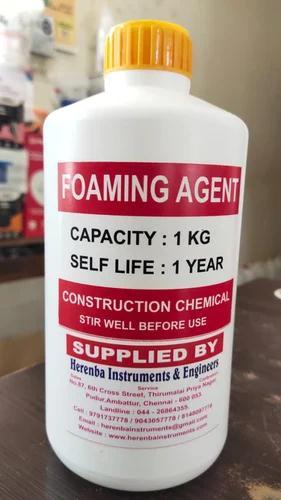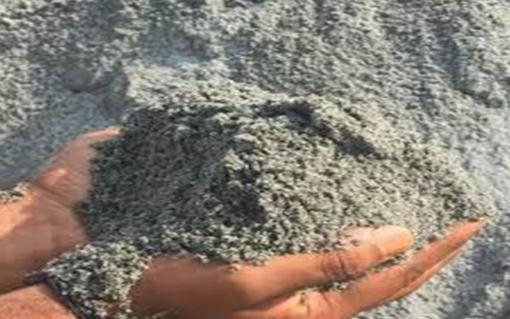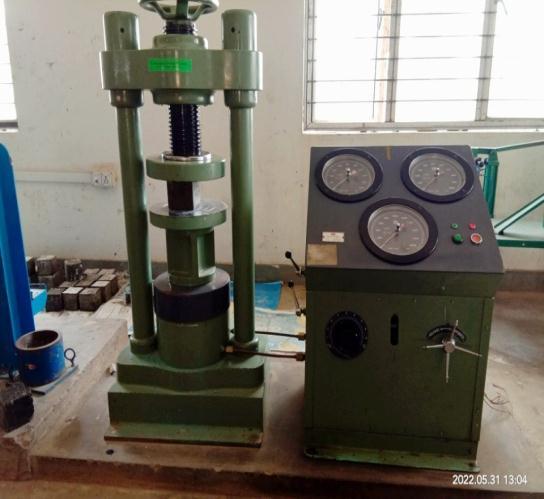International Research Journal of Engineering and Technology (IRJET) e ISSN: 2395 0056

Volume: 09 Issue: 07 | July 2022 www.irjet.net p ISSN: 2395 0072
GGBS based geo-polymer light weight concrete by using foaming agent.

***
Abstract:Inthisproject,geopolymerconcreteismade using the geopolymer technology. GGBS will be mixed with an alkaline activator solution (a mixture of sodium silicate and NaOH) and foam to generate lightweight concrete. NaOH pellets will be diluted with distilled watertocreatetheNaOHsolution.Ahomogenousslurry made from the Reactives will be combined to make it, after which it will be poured into a specific mould and allowedtocurefor24hoursatroomtemperature.After thecuringprocedure,thesamples'compressivestrength willbeassessedondays3,7,and14.
KEYWORDS: GGBS, M Sand, Light Weight, Molarity, FoamingAgent
1. INTRODUCTION:
Concrete, a widely used building material, makes the best foundations, architectural structures, bridges, roadways, block walls, fences, and poles. One tonne of Portlandcementrequirestheproductionofonetonneof CO2, which is then discharged into the environment. About 65 percent of the greenhouse gases responsible for global warming are made up of CO2. The manufacturing of ordinary Portland cement (OPC) is estimated to generate 1.35 billion tonnes annually, or around7%ofallgreenhousegasemissionstotheearth's atmosphere. However, a lot of energy is used in the cement business. The next most energy intensive operation is the production of Portland cement, which requires4GJofenergypertonne.Aftertheironandsteel andthermalpowerindustries,theIndianWhenitcomes to coal use, the cement industry came in third. The industry'scapacitywasaround198milliontonnesatthe beginning of the fiscal year 2008 2009. India's demand for cement is expected to rise by 10% a year over the next few years, thanks to investments in housing, infrastructure, and corporate capital. The demand supplysituationinthecementsectorislikelytoimprove starting in 2008 09, with production and consumption expected to increase by 9 to 10%. (2007) Ragan and Hardjito(2006).
Granulated blast furnace slag is a byproduct of the blast furnaces used to make iron (GGBS). GGBS is a granular, non metallic material that is mostly composed of silicates and calcium aluminates. GGBS's particle size is quite comparable to cement's. In order to increase the workability, density, durability, and alkali silica reaction resistance of the concrete, GGBS is routinely combined withPortlandcementasalow costfiller.Thereisahigh
possibilityforcontaminationsinceGeopolymerConcrete (GPC) uses all classes and grades of GGBS through the application of the appropriate process technology. becauseofthis,themixdesignforthisgeopolymermixis determined by trial and error. GGBS and water were added to make a slurry, which was then used to create foamconcreteintwophases.Pre foamwasmadeusinga liquid foaming component. Initially, sand, coarse aggregate, and GGBS were well blended. Water is then added to the mixture and well mixed in until the appropriate consistency is achieved. Water and a foaming agent were combined to make pre foam separately.TheGGBSslurryisthenmixedwithpre foam.
Materials
2.1
GGBS USED:
Molten iron blast furnace slag can be cooled in water or steamtoproduceglassygroundgranulatedblastfurnace slag.
FIG 2.1GGBS PASTE2.2: Agent Foaming:
Dew Foam LW is a concrete air entraining additive developedfromcarefullyselectedpolymerswiththeaim of evenly dispersing tiny air bubbles throughout the concrete mixture. The cohesiveness and freeze thaw resistanceoftheconcretecanbeimprovedbyusingthis effect.
International Research Journal of Engineering and Technology (IRJET) e ISSN: 2395 0056

Volume: 09 Issue: 07 | July 2022 www.irjet.net p ISSN: 2395 0072
= 3.75 kg; coarse aggregates = 6.25 kg; foaming agent = 20ml.

Amixdesignfortypicalconcretewascreatedinthis studyutilisingtheaspercodebook456:2000technique.
Concretemixdesignistheprocessofchoosingtheright materialsforconcreteanddeterminingtheirproportions withtheaimofgeneratingthecheapestconcretewhile retainingtherequiredminimumcharacteristicslike strength,durability,andconsistency
Calculatingthemixforstandardconcrete
Tomakeninecubes(100mmx100mmx100mm)
2.3 M SAND:
FIG 2.2 Foaming Agent
Manufactured sand can be used in place of natural sand (M sand). Manufacturing sand is made by crushing hard granitestone.M sandhasasizeoflessthan4.75mm.

Fineaggregatesareequalto3.75kg,coarseaggregateis equalto6.25kg,andcementweighs2.5kg.
Thefollowingcomponentsmakeupthemethodologyfor the current work: • GGBS will be used as the starting material to create geopolymer concrete; • Alkaline activators, like sodium hydroxide and sodium silicate, will be used to create the process for creating geopolymer concrete; and • The properties of GGBS based on geopolymer concrete will be observed, particularlyitscompressivestrength.
DETAILED PROCEDURE
Compression testing, material selection, mix proportioning,specimen preparation/casting, and specimenpreparation.Results
PROPORTIONING THE MIX FOR THE NINE CUBE (100mmx100mmx100mm)
2.4 Mix Design:
Geopolymer concrete does not yet have a defined mix design. The strength of cement concrete is known to be influenced by the water to cement ratio, but this is not always the case. because of this, the mix design for this geopolymer mix is determined by trial and error. GGBS andwaterwereaddedtomakeaslurry,whichwasthen used to create foam concrete in two phases. Pre foam was made using a liquid foaming component. Initially, sand, coarse slurry is aggregate, and GGBS were well blended. Water is then added to the mixture and well mixed in until the appropriate consistency is achieved. Waterandafoamingagentwerecombinedtomakepre foamseparately.TheGGBSthenmixedwithpre foam.
CalculatingthemixforGGBSconcrete:
Fornine100mmx100mmx100mmcubes,thefollowing quantitiesshouldbeused:GGBS=2.5kg;fineaggregates
GGBS weighs 2.5 kilogrammes, fine aggregates 3.75 kilogrammes, coarse aggregate 6.25 kilogrammes, and foamingagent20millilitres.
PREPARE/FORMULATE SPECIMENS:
First,aweighedquantityofsodiumhydroxide(NaOH)in flakes and sodium silicate to fit 4 Molarity are dissolved in a specified amount of purified water (4M). After that, themixtureisswirledferociouslywithaglassroduntilit hascooled.Thefinalproductwaskeptinabeakerfor24 hours. The alkaline solution and polymerization process may mix while you wait. Sodium hydroxide and sodium silicate were added to the dry mixture of GGBS, fine aggregate, and coarse aggregate on a metallic tray. Additionally, a calculated amount of foaming agent was used. The mix proportions of GGBS, fine aggregate, and coarse aggregate in the current experiment were 1: 1.5: 2.5. Prior to now, the dry ingredients had been thoroughly mixed for five minutes. The freshly mixed concrete was poured into moulds right away. Concrete
International Research Journal of Engineering and Technology (IRJET) e ISSN: 2395 0056

Volume: 09 Issue: 07 | July 2022 www.irjet.net p ISSN: 2395 0072
cubesmeasuring100x100x100mmthathadjustbeen pouredwerecasttotestthecompressivestrength.After casting for ambient curing, all of the specimens were stored at room temperature, and after being remoulded the next day, they were all kept there until the testing day. The cast cubes underwent compression testing in a machine to ascertain their compression strength at 3, 7, and 14 days after ambient curing. The results were documented.
Calculations:3.1MixDesignCalculationsForNineCubes (100 mm x 100 mm x 100 mm) • GGBS = 2.5 kg • Fine Aggregates = 3.75 kg • Coarse Aggregates = 6.25 kg • FoamingAgent=20ml
3.2 Test of compressive strength Estimation:
Compression testing was finished in accordance with IS 516:1959 standards. Every single sample of concrete was put through compression testing with a 1000 KN capacity.Concretecubesof100mmx100mmx100mm were subjected to a crushing strength test, and the results were positive. The maximum load placed on the samples was calculated by dividing the failure load by the area of the specimens' ultimate compressive strength. The following chapter's graphs show the resultsaftertheyhavebeenplotted.
3.2 Geo polymeric concrete cubes with a 3 molarity compression strength test
Geo polymer concrete Block
3 rd DAY Molarity=4 7 rd DAY Molarity=4 14 rd DAY Molarity=4
Weight (Kg) 2.3 2.35 2.28 Load (KN) 70 133.3 175 Stress (N/mm²) 7 13.3 18
3.4 Compressive strength test of geo-polymeric concrete cubes with 6 molarity
Geo polymer concrete Block
3 rd DAY Molarity=6 7 rd DAY Molarity=6 14 rd DAY Molarity=6
Weight (Kg) 2.45 2.5 2.42 Load (KN) 234 300.3 393.3 Stress (N/mm²) 23.4 30.03 39.3
3.5 Compressive strength test of geo polymeric concrete cubes with 8 molarity
Geo polymer concrete Block
3 rd DAY Molarity=8 7 rd DAY Molarity=8 14 rd DAY Molarity=8
Weight (Kg) 2.4 2.4 2.38 Load (KN) 307.3 350 400 Stress (N/mm²) 31 35 40
Fig 3 Compressive Strength testing Machine

International Research Journal of Engineering and Technology (IRJET) e ISSN: 2395 0056

Volume: 09 Issue: 07 | July 2022 www.irjet.net p ISSN: 2395 0072
Graph off comparison of cement concrete and geo polymer(4MOLARITY)compressivestrength.
geopolymerconcretemadeofflyashandGGBSperforms in an acidic environment "by D. Lavanya and J. Guru Jawaharinvolume3,number8,August2016.
Theuseofcoarseandfinebrokenbricksasaggregatein concrete. Debieb F, Kenai S. 2008; 22:886 93 ConstructionBuildingMaterial
Geopolymer Concrete
Normal concrete
Environmental pollution from rural brick making operations and its impact on employees' health, accordingtoXiaohengWang(2010)
• M.S. Shetty, Concrete Technology Theory & Practice, RamNagar,NewDelhi:S.CHAND&Co.
Foamed Concrete: A Dutch View, by S. Van Deijk, BRE, 1992,pp.2 8.
• Foam cellular concrete, as per IS 2185(Part 4):2008 ConcreteMasonryUnitsSpecification,part4.
4. SUMMARY
•Thecompressivestrengthofambient curedspecimens at 14 days is greater than that of conventional concrete foralkalinemolarityof8molar.
•Thecompressivestrength ofambientcuredspecimens at14daysisabout1.5timesthatofregularconcretefor analkalinemolarityof8molar.
• After being cured in an ambient laboratory environment, the compressive strength of geopolymer concretemadewithGGBSgetsstrongerovertime.
•Thegreatestcompressivestrengthof100%GGBSat14 daysafterambientcuringwas40MPa.
Thecompressivestrengthofgeopolymerconcretebased onGGBSincreasesasthealkalinesolutionconcentration rises. Several technical articles form the basis of this analysis.
• The compressive strength of concrete grows proportionallywithageandreachesacertainage.
•Asaresult,wesuggestutilisinglightconcretewithan8 molarity that is GGBS based. after 14 days of ambient curing,NaoHandNa2siO3havereachedtheirmaximum compressivestrength.
References ShankarH. Sanniand Khadiranaikar'sarticle "Performance of Geopolymer Concrete in the Harsh Environmental Circumstances" from R.B., volume 3, no. 2,2012.
• GGBS and flyash based geopolymer concrete "in 2016 by K Prasanna and Lakshminarayana.B. 3. How well
•Inachlorideenvironment,S.Sarker,M.A.Hussain,and O.C. Debnath's study on the strength behaviour of geopolymer concrete based on slag (GGBS) was publishedinDecember2016.
• "Behavior of Geopolymer Concrete Containing GGBS" by Devender Singh and Er Ravinder Kumnar in September2017,issue6,number5[6].
BIOGRAPHIES
Mr. Manjunath M Katti
Asst.Professor DepartofCivilEngineering ChannabasaveshwaraInstitute ofTechnology,Gubbi


Peer Maroof Ahmad

BEFinalyearstudent CivilDepartment
ChannabasaveshwaraInstitute ofTechnology,Gubbi
PRIYANKA C H
BEFinalyearstudent CivilDepartment
ChannabasaveshwaraInstitute ofTechnology,Gubbi
International Research Journal of Engineering and Technology (IRJET) e ISSN: 2395 0056

Volume: 09 Issue: 07 | July 2022 www.irjet.net p ISSN: 2395 0072
SUMA JM
BEFinalyearstudent CivilDepartment
ChannabasaveshwaraInstituteof Technology,Gubbi
Devindrappa
BEFinalYearStudent CivilDepartment
ChannabasaveshwaraInstituteof Technology,GubbiBEFinalyear student


